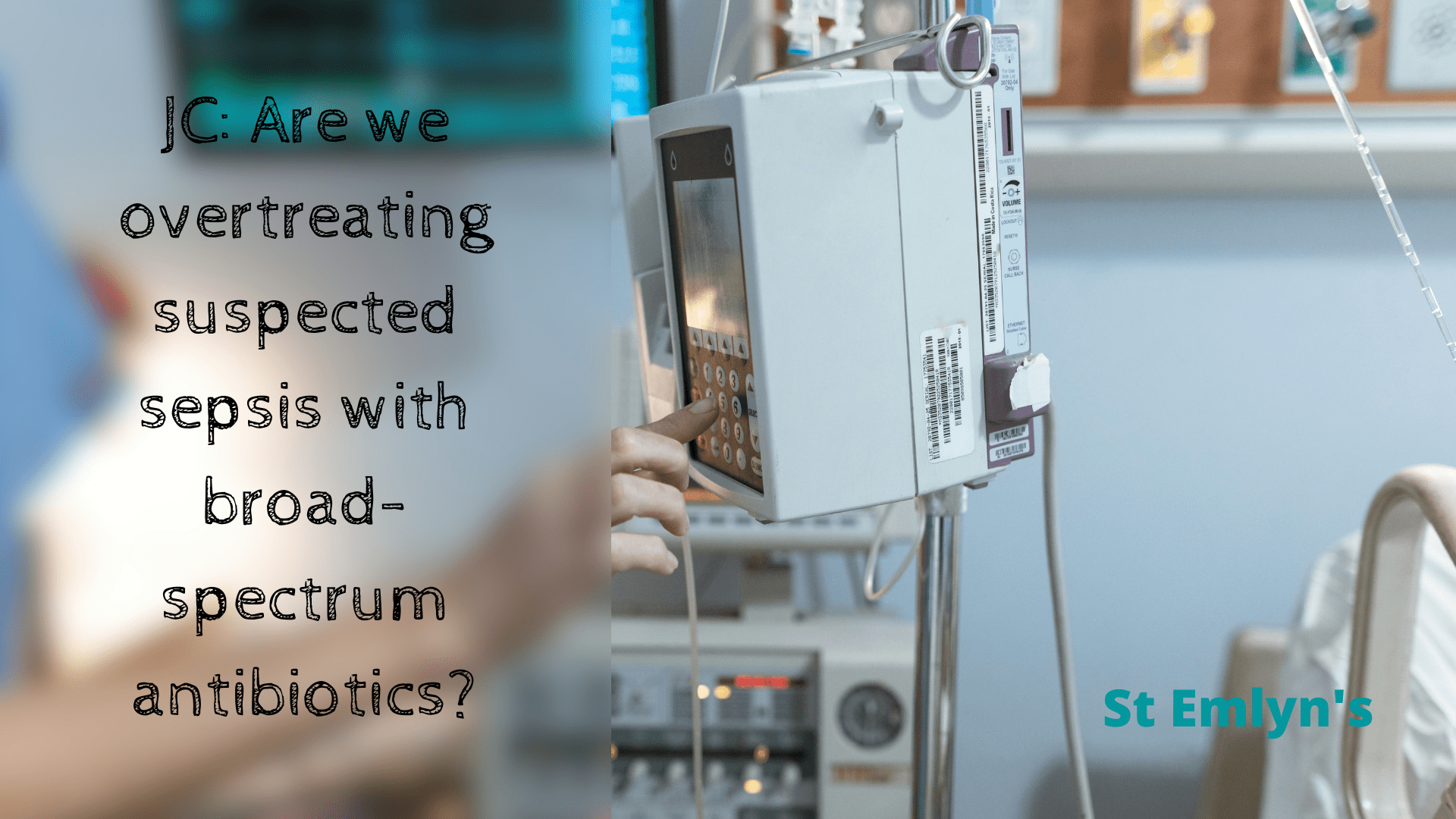Sepsis guidelines tell us to act fast. Blood cultures, lactate and broad-spectrum antibiotics within the hour. The Surviving Sepsis Campaign and SEP-1 quality measures have drummed this message home for years. But have we created a problem in our rush to save lives? Are we reflexively reaching for broad spectrum antibiotics when simpler antibiotics would do, or worse, when antibiotics aren’t needed at all?
This paper from Clinical Infectious Diseases tackles these uncomfortable questions head-on by looking at what actually happened to 600 patients treated with broad-spectrum antibiotics for suspected sepsis in American emergency departments. The findings are striking, and they raise important questions about how we approach sepsis in the ED.
Here is the abstract; as always we encourage you to read the whole paper. It is sadly not open access, but the helpful librarian at our Trust’s library were able to retrieve it for me at no cost:
Abstract
Background: Treatment guidelines recommend rapidly treating all patients with suspected sepsis with broad-spectrum antibiotics. This may contribute to antibiotic overuse. We quantified the incidence of antibiotic overtreatment and possible antibiotic-associated harms among patients with suspected sepsis.
Method: We reviewed the medical records of 600 adults treated for suspected sepsis with anti–methicillin-resistant Staphylococcus aureus and/or antipseudomonal β-lactam antibiotics in the emergency departments of 7 hospitals, 2019–2022, to assess their post hoc likelihood of infection, whether narrower antibiotics would have sufficed in retrospect, and possible antibiotic-associated complications. We used generalized estimating equations to assess associations between likelihood of infection and hospital mortality.
Results: Of 600 patients, 411 (68.5%) had definite (48.0%) or probable (20.5%) bacterial infection and 189 (31.5%) had possible but less likely (18.3%) or definitely no (13.2%) bacterial infection. Among patients with definite/probable bacterial infection, 325 of 411 (79.1%) received antibiotics that were overly broad in retrospect. Potential antibiotic-associated complications developed in 104 of 600 (17.3%) patients within 90 days, most commonly new infection or colonization with organisms resistant to first-line agents (48/600 [8.0%]). Mortality was higher for patients with less likely/definitely no bacterial infection versus definite/probable bacterial infections (9.0% vs 4.9%; adjusted odds ratio [aOR], 2.25 [95% confidence interval{CI}, 1.70–2.98]), but antibiotic-associated complication rates were similar (14.8% vs 18.5%; aOR, 0.79 [95% CI, .60–1.05]).
Conclusions: Among 600 patients treated with broad-spectrum antibiotics for possible sepsis, 1 in 3 most likely did not have a bacterial infection, 4 in 5 of those with bacterial infections were treated with regimens that were broader than necessary in retrospect, and 1 in 6 developed antibiotic-associated complications.
What kind of paper is this?
This is a retrospective cohort study involving detailed medical record reviews of 600 adults treated for suspected sepsis (defined as blood cultures drawn, lactate measured and intravenous antibiotics given) who received broad-spectrum therapy (anti-MRSA and/or antipseudomonal β-lactam antibiotics) in the EDs of 7 hospitals across California, Iowa and Massachusetts between 2019 and 2022.
The reviewers were attending physicians, fellows, or clinical pharmacists in emergency medicine, infectious diseases, or pulmonary/critical care. They retrospectively assessed the likelihood of bacterial infection, whether narrower antibiotics would have sufficed, and potential antibiotic-associated complications.
Tell me about the patients
The study reviewed 600 randomly selected patients from 46,245 who were treated for suspected sepsis during the study period. Of those treated for suspected sepsis, 57.4% received anti-MRSA and/or antipseudomonal β-lactam antibiotics.
The median age was 64 years, 55% were male, 70% were non-Hispanic White, and comorbidities were common (median Elixhauser score of 9). The most commonly administered antibiotics in the ED were vancomycin (64%), cefepime (47%) and piperacillin-tazobactam (39%).
Sepsis was explicitly documented on the differential diagnosis by ED providers in 63% of cases, and sepsis or bacterial infection was identified as the most likely final diagnosis in 87% of cases.
What were the interventions?
There weren’t interventions in the traditional sense. This was an observational study where trained clinicians retrospectively reviewed all available medical records to classify patients into four categories based on the post hoc likelihood of bacterial infection:
- Definite bacterial infection (48.0%)
- Probable bacterial infection (20.5%)
- Possible but less likely bacterial infection (18.3%)
- Definitely no bacterial infection (13.2%)
For patients with definite or probable infection, reviewers assessed whether the antibiotics given were adequate and whether narrower agents would have sufficed in retrospect. They also looked for antibiotic-associated complications within 90 days.
What did they find?
One in three patients likely didn’t have a bacterial infection at all. When combining the “possible but less likely” and “definitely no” categories, 31.5% of patients treated with broad-spectrum antibiotics for suspected sepsis likely had non-bacterial conditions. The most common alternative diagnoses were viral infections (21%), haematologic/oncologic disease (13%) and gastrointestinal conditions like GI bleeds and pancreatitis (12%).
Four in five patients with bacterial infections received unnecessarily broad antibiotics. Among the 411 patients with definite or probable bacterial infection, 325 (79.1%) received antibiotics that were broader than necessary in retrospect. The causative organisms were most commonly E. coli (14%), S. aureus (10%), Streptococcus species (8%) and Klebsiella species (8%). Only 24% of patients with identified organisms actually needed coverage broader than ceftriaxone.
Overall, 87% may have been overtreated. Combining those without bacterial infection (189 patients) with those who had infection but received unnecessarily broad antibiotics (325 patients), 514 of 600 patients (86.7%) were overtreated in some fashion.
One in six developed antibiotic-associated complications. A total of 104 patients (17.3%) developed potential antibiotic-associated harms within 90 days, including new resistant organism colonisation/infection (8.0%), acute kidney injury (2.7%) and C. difficile infection (2.0%). Interestingly, complication rates were similar whether patients actually had bacterial infections or not (18.5% vs 14.8%).
And finally, patients without bacterial infection had higher mortality. Those with less likely or definitely no bacterial infection had a 9.0% in-hospital mortality compared to 4.9% in those with definite/probable infection. After adjustment, this gave an odds ratio of 2.25 for death. This likely reflects the severity of their underlying non-infectious conditions, and possibly delays in diagnosing and treating the actual problem, whilst focusing on presumed sepsis.
What does this mean?
This study provides evidence for something many of us have suspected: in our efforts to treat sepsis quickly, we’re casting the antibiotic net far too wide. The pressure from sepsis bundles and quality measures has created a culture where broad-spectrum antibiotics are the default for any patient who looks unwell.
The distinction between unnecessary and overly broad coverage matters. The authors make an important point: some unnecessary antibiotic use in the ED may be unavoidable given diagnostic uncertainty and the serious consequences of delayed treatment in true sepsis. However, the overuse of broad-spectrum coverage (anti-MRSA and antipseudomonal agents) is more immediately actionable. Do we really need vancomycin and cefepime for everyone, or could we be more selective?
The findings align with emerging evidence. Previous studies have shown that 20-40% of patients treated for sepsis likely don’t have bacterial infections, and that most patients could be managed with narrower-spectrum agents. This study extends that work by using detailed chart reviews that account for patient-specific factors like allergies and prior resistant organisms, not just culture results.
Local context is everything, and UK practice differs substantially from the US. Only 6.6% of patients with identified organisms had Pseudomonas, and about 10% had organisms resistant to ceftriaxone. This study reflects US practice where SEP-1 and Surviving Sepsis Campaign bundles have created quite rigid protocols. In the UK, we generally have more stratified approaches with antibiotic formularies aligned to local antibiograms. A
At most NHS trusts we wouldn’t routinely give piperacillin-tazobactam to every patient with suspected sepsis. Although there is probably a case to answer for escalating every well-appearing patient with possible neutropenic fever and a NEWS of 0 to broad-spectrum agents, especially when an FBC result can reasonable be returned within an hour. The paper’s findings on overtreatment may therefore be less pronounced in UK practice, though we should still scrutinise our own prescribing patterns.
Critical appraisal points
Retrospective bias is inherent. Determining the likelihood of bacterial infection retrospectively is somewhat subjective, especially in culture-negative cases. The authors mitigated this through structured reviews, consensus definitions, and group discussions of challenging cases, but the potential for bias remains. The detailed case examples in Table 1 are helpful for understanding how determinations were made.
Selection bias towards broad-spectrum users. The study only included patients who received anti-MRSA and/or antipseudomonal antibiotics (57% of suspected sepsis patients). We can’t extrapolate these findings to patients treated with narrower agents. The study specifically addresses whether broad coverage is overused, not whether antibiotics in general are overused.
Determining antibiotic necessity is complex. The authors focused on whether narrower antibiotics would have worked in retrospect, not whether the initial choice was reasonable. A patient with suspected MRSA bacteraemia might have been appropriately started on vancomycin given fulminant shock even though a different antibiotic may later be revealed through the retrospectoscope.
Antibiotic-associated harm attribution is difficult. It’s impossible to be certain whether adverse events were due to initial empiric antibiotics, subsequent antibiotics, or other causes. The 17% complication rate may be an overestimate if other factors contributed.
Generalisability questions. The study included academic and community hospitals from three US states, but local antimicrobial resistance patterns vary. The findings may not apply everywhere, particularly to institutions with higher rates of resistant organisms.
Study period includes COVID-19. Data collection from 2019-2022 spans the pandemic, which may have influenced both antibiotic prescribing patterns and the mix of patients presenting to EDs.
What questions does this raise and should we change practice?
This study provides evidence that we’re possibly overtreating suspected sepsis with broad-spectrum antibiotics. Whilst some unnecessary antibiotic use may be unavoidable given the stakes involved and diagnostic uncertainty, the routine use of broad-spectrum agents for all comers deserves scrutiny.
Question reflexive broad-spectrum coverage. Not every unwell patient needs vancomycin and an antipseudomonal β-lactam. If sepsis is suspected, consider whether the clinical syndrome, local antibiogram, and patient-specific factors (prior MRSA, neutropenic fever) genuinely justify broad-spectrum coverage.
Consider early de-escalation. The study found that 17% of patients developed antibiotic-associated complications. Once cultures are back and clinical trajectory is clear, narrow or stop antibiotics promptly.
Focus on diagnostic accuracy. The higher mortality in patients without bacterial infection suggests we may be delaying diagnosis of the real problem whilst chasing presumed sepsis. Maintain a broad differential and be willing to pivot away from infection when it doesn’t fit.
Local antibiograms matter. Know your local resistance patterns. In many UK hospitals, community-acquired MRSA is rare, and routine anti-MRSA coverage may not be justified.
Balance guidelines with clinical judgment. Sepsis guidelines and quality measures serve an important purpose, but they shouldn’t override clinical reasoning. If a patient doesn’t look septic, don’t force the diagnosis just to tick boxes.
Consider decision support tools. The authors suggest computerised clinical decision support could help estimate the probability of resistant organisms and guide more appropriate antibiotic selection, similar to tools that have reduced overtreatment in UTI and pneumonia.
UK context: we may already be doing better. As already mentioned, most NHS trusts have antibiotic formularies aligned with local antibiograms and more stratified protocols based on clinical risk. We’re generally less bound by the rigid “antibiotics within an hour for everyone” mentality that US SEP-1 bundles have created. Especially when the differential is wider than sepsis. Question whether broad-spectrum coverage is genuinely needed, use local guidance, and don’t let protocol override clinical judgment.
The debate about sepsis bundles and early antibiotics will continue. This study won’t resolve it, but it does provide important data about the downstream consequences of our current approach.
Clinical bottom line
The best outcome would probably be what the authors suggest: refined guidelines for broad-spectrum coverage in suspected sepsis that balance the need for speed against the harms of overtreatment. Until then, we need to think critically about every broad-spectrum antibiotic order we place.
Reference
Shappell CN, Yu T, Klompas M, et al. Frequency of Antibiotic Overtreatment and Associated Harms in Patients Presenting With Suspected Sepsis to the Emergency Department: A Retrospective Cohort Study. Clin Infect Dis. 2025;80(6):1197-1207. doi:10.1093/cid/ciaf118










